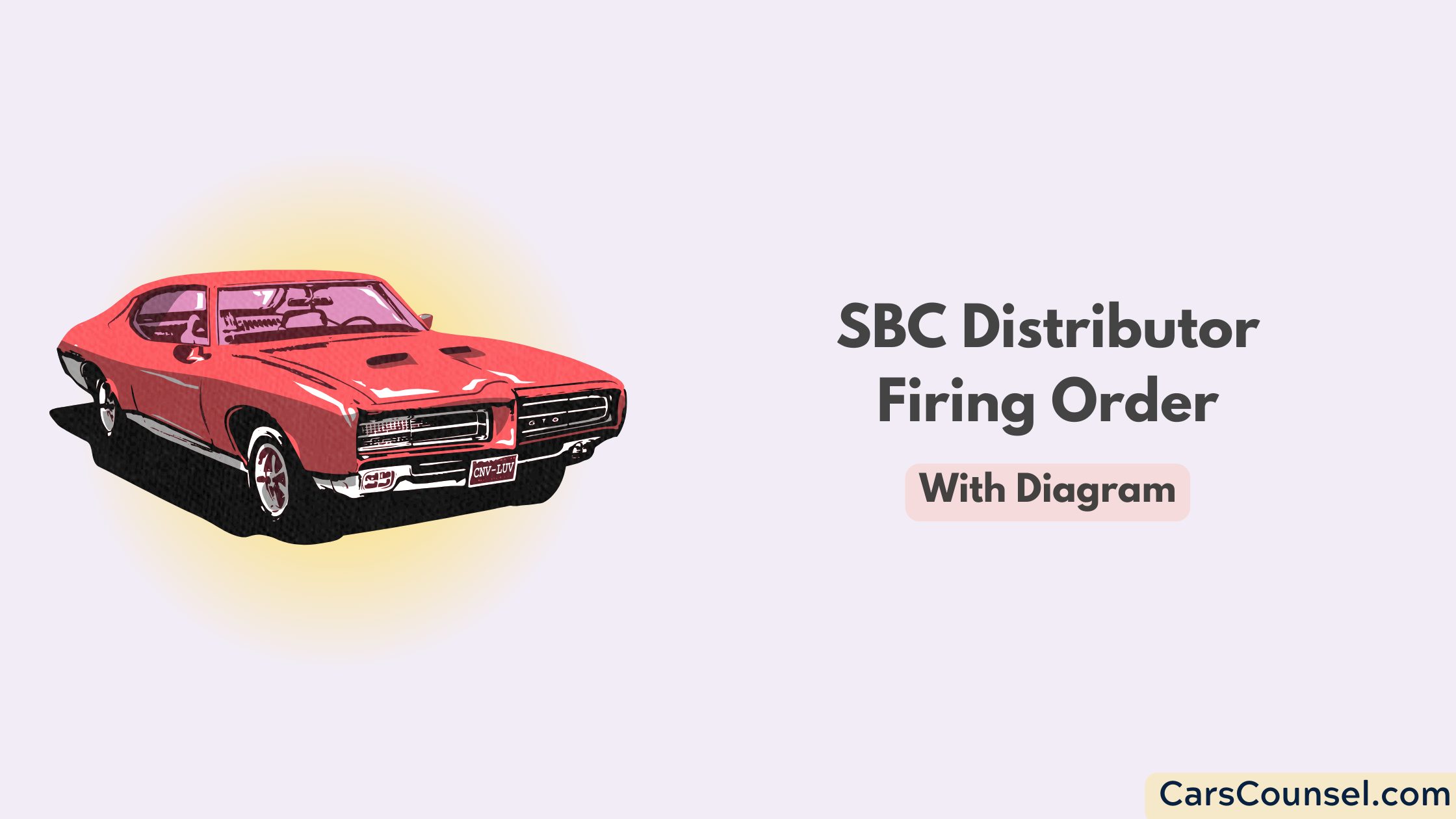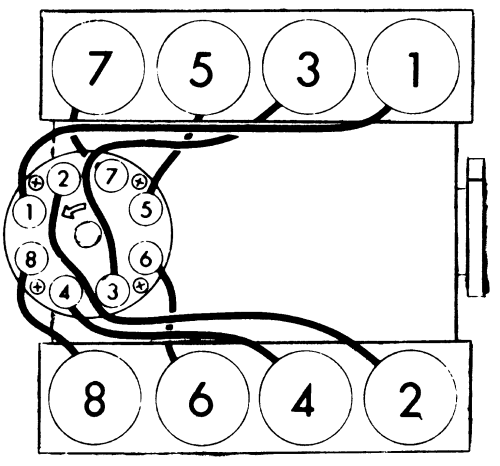The way your Small Block Chevy (SBC) engine fires is in this order: 1-8-4-3-6-5-7-2.

Imagine your distributor cap as a clock, the first plug wire is at the ‘5’ position. Your distributor turns in the opposite direction to a clock, which is the same way your engine turns. Look at a diagram to understand this better.
If you connect the spark plug wires wrongly, your engine might not work well or it might misfire. Make sure these connections are correct.
If you are tuning your SBC engine, this is where you start with the right timing and torque adjustments. Stick with us to get the most out of your engine.
Quick Navigation
Key Takeaways
- The firing sequence for the SBC V8 engine is 1-8-4-3-6-5-7-2, which is important for the engine to work properly.
- If you connect the spark plug wires wrong, the engine might not run smoothly or it might misfire.
- The distributor cap looks like a clock, but the number one is at the fifth hour and it spins the opposite way.
- This firing sequence works for many Chevrolet V8 engines, including the 350, 305, 400, 327, and 283.
- To make sure you’ve connected the spark plug wires correctly, always double-check with the firing order diagram.
Understanding SBC Distributor Firing Order

To really get the SBC distributor firing order, you need to know that the SBC V8 engine fires in a set order: 1-8-4-3-6-5-7-2. Think of the distributor cap as a clock, with number one at the fifth hour, and the numbers going around in a clockwise direction. Getting this order right is key for your engine to work well and for adjusting the timing.
If you mess up this pattern, your engine might run badly or not start at all. If you’re trying to make your engine perform better, you might think about changing the firing order. But be careful: if you get it wrong, you could damage the engine. If you get it right, your engine could run more smoothly and powerfully.
Detailed SBC Firing Order Diagram
When you look at a detailed diagram for the SBC firing order, you’ll see that the sequence goes like this: 1-8-4-3-6-5-7-2. This order is very important because it affects how the spark plug wires are set up.
You start at the first position and connect the spark plug wires in this exact order, going in a circle from left to right. This makes sure the right cylinder fires off at the right time, which really impacts how your engine runs.
If the wires aren’t connected right, you can end up with problems like your engine running rough or misfiring. So, it’s really important to make sure the spark plug wires match up with the distributor cap exactly like the diagram shows for the best engine performance.
Always double-check your wire connections with the diagram to make sure they’re correct.
Applicability of Firing Order
Looking at why the firing order is important, we see it’s used in many Chevrolet V8 engines, like the 350 (5.7L), 305 (5.0L), 400 (6.6L), 327 (5.4L), and 283 (4.6L).
The firing order affects how well the engine runs. A correct firing order makes sure the engine runs smoothly and stops problems like misfires or backfires. It’s important to stick to the right order to get the most power and best fuel use.
If the spark plug wires aren’t connected to the distributor cap in the right order, it messes up the firing sequence. This can make the engine run poorly, use more fuel, and even damage the engine.
Torque Specifications Overview
Knowing the order in which your engine fires is crucial for getting the best performance out of it. It’s just as crucial to know your car’s torque specifications, which are the measures of the twisting force that makes your engine run. This directly affects your car’s power and how well it runs.
For example, different Small Block Chevy (SBC) engines have different torque specifications. The Chevrolet 350 V8, for instance, has 365 horsepower and 405 pound-feet of torque. But keep in mind that these numbers can change if you modify the engine. Adding something like a blower can greatly increase torque, which in turn raises horsepower.
Distributor Rotation Explained
When talking about your Small Block Chevy (SBC) engine, the way the distributor spins is really important for how well your car runs and when it starts. The distributor in an SBC engine turns in the opposite direction of the clock, while the rotor inside it spins like the hands on a clock when the engine is running. This spinning comes from the camshaft, and it’s really important for making adjustments to when the engine starts and for keeping the ignition system working right.
If the distributor isn’t spinning right, it can cause issues with when the engine starts, make the engine not run as well, or even damage the engine. So, it’s really important to understand how the distributor spins to keep your SBC engine working at its best. You should always make sure that your distributor is put in right and spinning the way it should. Checking it regularly as part of keeping your ignition system working right can stop problems from happening and keep your car running great.
Initial Timing in Small Block Chevy
Setting up your Small Block Chevy engine requires you to set the initial timing correctly. This timing is important because it affects how your engine performs. Think of it as a starting point for tuning your engine’s performance in the future.
Here’s a simple guide for setting the initial timing:
- For a standard Small Block Chevy engine, set it between 8 to 12 degrees Before Top Dead Center (BTDC).
- If your engine is performance-tuned, the best setting will depend on your specific engine model and any changes you’ve made to it.
- For high-performance engines, check the manufacturer’s guidelines.
- If you have a mild street engine, a good range is 10 to 12 degrees BTDC.
- For racing engines, set between 14 to 16 degrees BTDC.
After setting the initial timing, you can start fine-tuning the engine’s performance. Remember, the best setting will depend on your specific engine model and any alterations you have made. So, you need to know what your engine requires and adjust it as needed.
Power in Small Block Chevy
Once you’ve adjusted your timing correctly, it’s time to focus on how much power your Small Block Chevy can make. This can really change how well it performs.
Think about making improvements like adding a high-flow air intake or exhaust system to raise the horsepower. You can also make changes to the engine, like adding a high-performance camshaft or bigger fuel injectors, to up the power.
It’s important to remember that a typical SBC will make between 200 to 300 horsepower. But, with the right improvements, you can make that number go up a lot. For instance, the LS9 engine in the Corvette ZR1, which is a type of SBC, can produce a whopping 638 horsepower.
It’s essential to make sure that every change you make works well with all the other changes, so you end up with a well-balanced, high-performance engine.
Similar Firing Order Engines
Even though the SBC V8 engine has a special sequence of how its cylinders fire, it’s cool to see that several other engines use a similar sequence. This helps them work better and use less energy. This doesn’t just happen by chance, but because of careful planning and building.
For example, the Pontiac Firebird uses the same firing sequence. This shows how flexible this sequence is, as the Firebird is famous for being strong and not wasting fuel.
The GMC Sierra also uses this firing sequence. This helps the Sierra to be great at towing and carrying heavy loads.
Other engines that use a similar firing sequence are found in popular cars like the Chevrolet Impala and the Chevrolet Camaro.
Conclusion
Now that you understand the firing order of the SBC distributor, your Chevy will perform better. Your car’s horsepower will increase, your torque will be more efficient, and your throttle will work better.
By setting the correct rotation and initial timing, your drive won’t just be a regular one – your Chevy will be more powerful. So, start the engine, feel the power, and know that you’ve successfully managed the key aspect of your small block Chevy.
The road is ready for you and your Chevy is ready to go.

